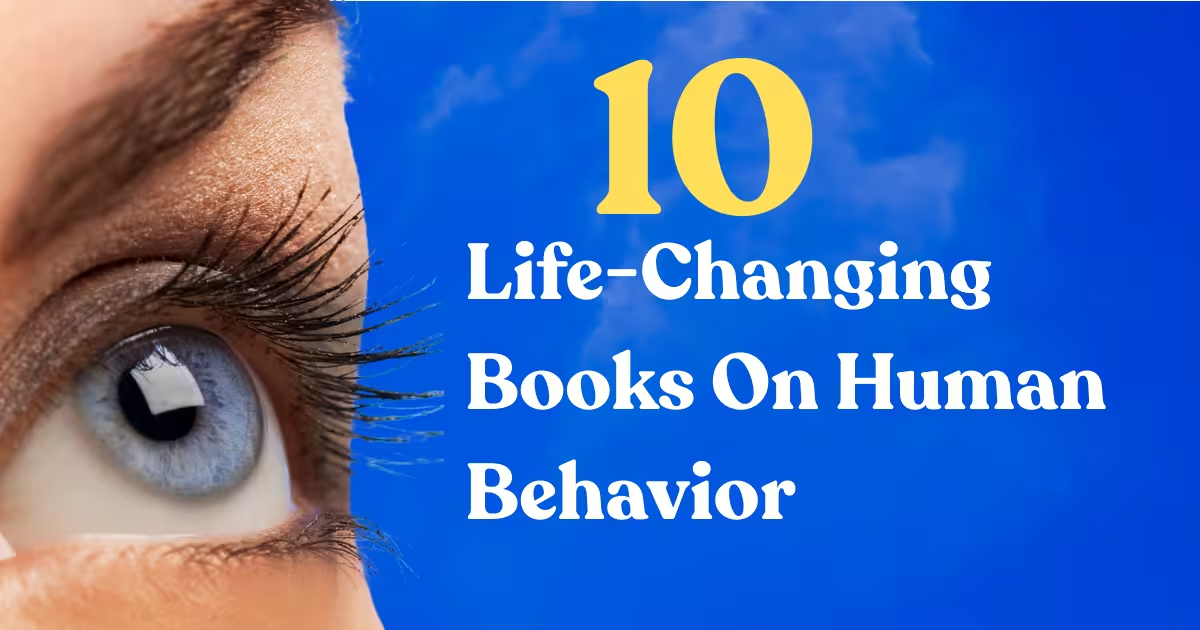I’ve spent the last few years deliberately reading books that promise one thing: a clearer understanding of human behavior—why people think, feel and act the way they do. Along the way, I underlined pages about cognitive biases, emotional intelligence, motivation, social psychology, and behavioral economics, and then tested those ideas in real conversations, work decisions and relationships.
This list of 10 psychology books isn’t theoretical for me; each one has quietly rewired how I read a room, make decisions, negotiate, argue, forgive, and even talk to myself. If you’ve ever wondered “Why did I do that?” or “Why do people behave so irrationally?”, these books will give you a language—and a toolkit—for understanding human behaviour at a deep level.
Use this as a reading roadmap to better decisions, better relationships, and a more realistic view of the human mind.
Table of Contents
Why Understanding Human Behavior Matters
We live in a time when we’re constantly nudged, persuaded and distracted—by algorithms, marketing, workplace incentives and social expectations.
Yet most of us still operate on outdated assumptions: that people are mostly rational, that more money always motivates, that “bad” actions come from “bad” people, or that IQ alone predicts success.
Research in psychology, neuroscience, and behavioral economics has repeatedly shown the opposite.
Books like Thinking, Fast and Slow and Predictably Irrational show how systematic our irrational decisions are. Emotional Intelligence reframes success in terms of self-awareness, empathy and social skills, rather than raw intellect. Influence and The Laws of Human Nature unpack the hidden motives and social pressures shaping behavior.
And Behave goes all the way down to the brain, hormones and evolution.
Taken together, these books form a kind of “user manual” for the human animal—useful whether you’re a leader, creator, partner, parent, or just trying not to be fooled by your own mind.
1. The Laws of Human Nature by Robert Greene
Brief Summary
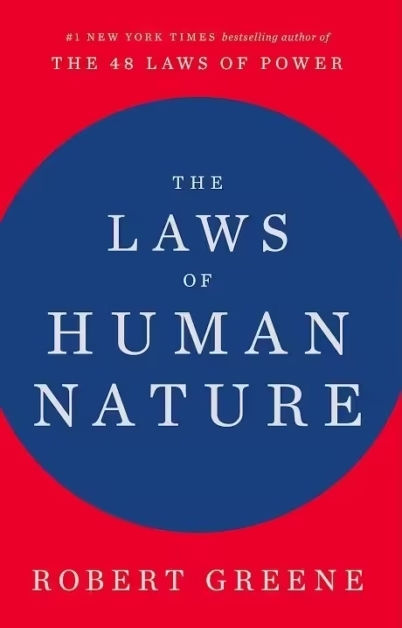
Reading The Laws of Human Nature felt like having someone finally name the patterns I’d been sensing in people for years but couldn’t articulate.
Greene distills human behavior into 18 “laws” that explain everything from irrational emotions and narcissism to group dynamics and aggression.
Each chapter blends psychology, philosophy and historical stories, showing how these laws have played out in real lives. The most useful part, for me, is that he doesn’t just diagnose; he prescribes. He shows how to observe others more clearly, recognize your own blind spots, and act strategically without becoming manipulative or cynical.
It’s a dense book, but if you’re serious about understanding human nature in relationships, leadership, and everyday life, it’s one of the most comprehensive guides out there.
Core Premise
Human nature follows consistent psychological patterns; if you can understand these patterns in yourself and others, you can respond more wisely instead of reacting blindly.
Key Lessons & Takeaways
- People are far more driven by emotion than by reason—watch feelings before arguments.
- Everyone wears a social mask; learn to read behavior, not words.
- Our “shadow” (denied traits) leaks out in sabotaging ways if we don’t integrate it.
- Envy, aggression and narcissism are universal; the question is how we channel them.
- Group dynamics can override individual rationality—be wary of crowds and tribes.
- Self-awareness is a competitive advantage: study your patterns like a scientist.
- Develop empathy by observing people’s body language, tone and small daily choices.
- Long-term influence comes from character and consistency, not quick tricks.
2. Thinking, Fast and Slow by Daniel Kahneman
Brief Summary
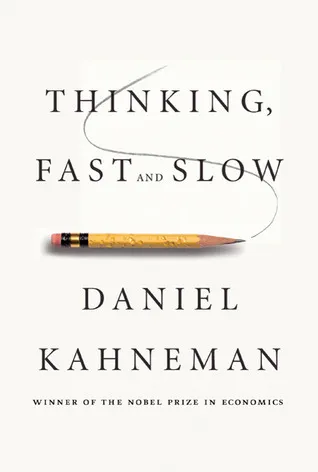
This book changed the way I interpret almost every decision I make. Kahneman describes two mental systems: System 1, our fast, intuitive, automatic thinking, and System 2, our slow, deliberate, analytical thinking.
The twist is that System 1, although efficient, is riddled with cognitive biases—like overconfidence, loss aversion, and anchoring—that quietly distort judgment. Thinking, Fast and Slow walks through decades of research showing how investors, doctors, judges and ordinary people consistently misjudge risks, probabilities and outcomes.
As I read, I kept spotting my own mind falling for the same traps. It’s not a light read, but if you want to understand the mechanics behind irrational decisions and learn to think a little more clearly, this is essential.
Core Premise
Our thinking is divided into a fast, intuitive system and a slow, rational one—and many of our errors come from over-relying on the fast system without realizing it.
Key Lessons & Takeaways
- System 1 is quick and effortless but biased; System 2 is slower and energy-intensive.
- We’re loss-averse: losses hurt more than equal gains feel good.
- Anchoring makes arbitrary numbers influence our estimates and decisions.
- Availability bias makes vivid stories feel more “true” than statistics.
- Overconfidence leads us to trust our gut far more than the data justifies.
- We misjudge probabilities and fall for “what you see is all there is.”
- Slowing down—literally pausing—lets System 2 correct some of System 1’s mistakes.
3. The Lucifer Effect by Philip G. Zimbardo
Brief Summary

This was one of the most unsettling books I’ve ever read about human behaviour. Zimbardo, famous for the Stanford Prison Experiment, explores how perfectly “normal” people can become cruel, abusive or complicit in evil when placed in certain environments.
He examines the prison experiment in detail, then connects it to real-world atrocities like Abu Ghraib. The book forced me to rethink easy explanations like “bad apples” and instead look at situations and systems—power structures, anonymity, dehumanization—that push people over the edge.
It’s not a comfortable read, but it’s crucial if you want a realistic, psychologically grounded understanding of how “good people” can participate in terrible things and how to design systems that minimize that risk.
Core Premise
Evil is often less about “bad people” and more about powerful situations and systems that distort behavior, erode responsibility and normalize cruelty.
Key Lessons & Takeaways
- Situations and systems can override personal morals shockingly quickly.
- Deindividuation (losing personal identity) makes people more likely to act aggressively.
- Dehumanizing language (“them”, “animals”, “vermin”) paves the way for abuse.
- Lack of oversight and accountability accelerates moral decline.
- Ordinary people can commit atrocities when obedience and conformity are rewarded.
- Heroism often means resisting the situation, not just “being a good person.”
- Design matters: ethical systems need checks, transparency and empowered whistleblowers.
4. Emotional Intelligence by Daniel Goleman
Brief Summary
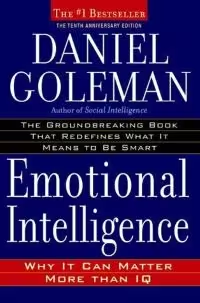
When I read Emotional Intelligence, I realized how many “smart” people I’d seen fail not from lack of IQ, but from poor self-awareness, impulse control or empathy.
Goleman pulls together research showing that EQ—skills like recognizing your emotions, managing them, understanding others and handling relationships—often predicts success better than traditional intelligence.
He breaks EQ into components: self-awareness, self-regulation, motivation, empathy and social skills, and shows how they show up at work, in leadership, and in personal life.
This book gave me a vocabulary for those “soft skills” that actually drive careers, relationships and mental health—and practical ideas for improving them, not just admiring them in others.
Core Premise
Being smart isn’t enough; the ability to recognize, manage and use emotions skillfully often matters more than raw cognitive ability.
Key Lessons & Takeaways
- Self-awareness is the foundation: you can’t manage what you don’t notice.
- Emotional hijacks happen when feelings override rational thinking; naming emotions helps.
- Empathy is a learnable skill, built through attention and curiosity about others.
- Motivation rooted in meaning outlasts external rewards and status.
- Social skills—listening, feedback, conflict resolution—are core leadership tools.
- EQ can be developed through practice, reflection and coaching.
- Managing negative emotions protects both relationships and physical health.
5. Games People Play by Eric Berne
Brief Summary
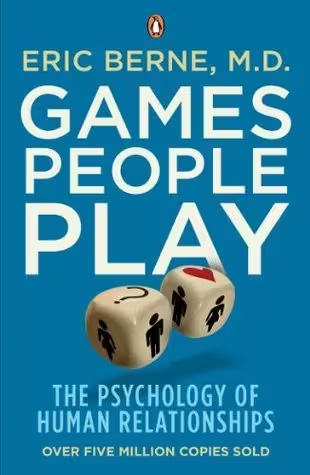
Games People Play gave me a new lens for those weird, repetitive conversations that never seem to go anywhere. Berne introduces Transactional Analysis, a framework that sees interactions as transactions between three ego states: Parent, Adult and Child.
He then describes the “games” we unconsciously play—like martyrdom, blame or helplessness—to get hidden emotional payoffs. Once I started recognizing these patterns in my own life, it became harder to get sucked into them.
The book is older and uses some dated language, but the core idea—that we often aren’t as “straightforward” as we think—is incredibly useful for understanding relationships, conflict and communication.
Core Premise
Much of everyday interaction consists of hidden psychological “games” that satisfy emotional needs; by seeing them clearly, we can step out of destructive patterns.
Key Lessons & Takeaways
- We switch between Parent, Adult and Child modes in conversation.
- Many arguments are actually rehearsed games with predictable scripts.
- Games deliver “payoffs” (like feeling superior or victimized) even when we suffer.
- Healthy interaction happens in Adult-to-Adult mode—curious, direct, respectful.
- Noticing your favorite games is the first step to changing them.
- You can refuse to play by responding differently than the script expects.
6. Influence by Robert B. Cialdini
Brief Summary
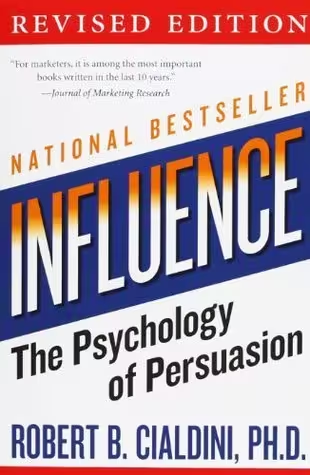
If you’ve ever wondered why you said “yes” to something and regretted it later, Influence will probably explain it. Cialdini condenses years of research into six principles of persuasion: reciprocity, commitment and consistency, social proof, authority, liking and scarcity.
When I started spotting these principles in marketing campaigns, sales pitches and even social media, it felt like finally seeing the strings behind the puppet show. The genius of the book is that it’s not just about defending yourself; it also shows how to use these principles ethically to communicate and lead more effectively.
It’s one of the most practical psychology books I’ve read for everyday life and business.
Core Premise
Our decisions are heavily shaped by a small set of psychological triggers, which can be used either to manipulate us or to guide us more constructively.
Key Lessons & Takeaways
- Reciprocity: we feel compelled to return favors (even unwanted ones).
- Commitment/Consistency: small public commitments lead to bigger follow-through.
- Social proof: we assume something is right if many people do it.
- Authority: titles, uniforms and expertise increase compliance.
- Liking: we say yes more to people we like or find similar.
- Scarcity: perceived rarity makes things more attractive.
- Ethical persuasion means using these tools transparently, not to exploit.
7. The Art of Thinking Clearly by Rolf Dobelli
Brief Summary

The Art of Thinking Clearly feels like a pocket guide to the many ways our thinking goes off the rails. Dobelli collects 99 cognitive biases and logical fallacies—like confirmation bias, survivorship bias and the sunk cost fallacy—and explains each in a short, punchy chapter.
I read it slowly, a few biases at a time, and started seeing them everywhere: in news headlines, office politics, and my own decisions.
It doesn’t go as deep into theory as Thinking, Fast and Slow, but it’s far more digestible day to day. If you want a practical tool to improve your decision-making and filter modern information overload, this is a very readable starting point.
Core Premise
Our brains use shortcuts that are great for survival but terrible for objective reasoning; recognizing those mental errors helps us think a little more clearly.
Key Lessons & Takeaways
- Cognitive biases are systematic, not random—your brain errs in predictable ways.
- Confirmation bias makes us seek evidence that supports what we already believe.
- Survivorship bias blinds us to the failures we don’t see.
- The sunk cost fallacy keeps us stuck in bad decisions to “justify” past effort.
- Learning to say “I don’t know” protects you from overconfidence.
- Good thinking often means slowing down and checking your assumptions.
8. Drive by Daniel H. Pink
Brief Summary
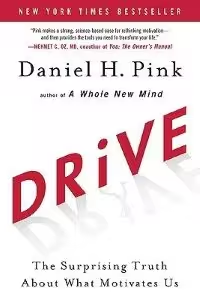
Drive made me rethink how I motivate myself—and how organizations motivate people.
Pink argues that traditional “carrot-and-stick” rewards (bonuses, threats, external pressure) work for simple, mechanical tasks but backfire for creative, complex work. Drawing on decades of research, he explains that real intrinsic motivation is built on three pillars: autonomy, mastery and purpose.
After reading it, I noticed how often systems unintentionally kill motivation by micromanaging people, hiding the bigger “why,” or making progress invisible. This book is especially relevant if you lead teams, freelance, or want to design a more satisfying career.
Core Premise
For meaningful work, humans are driven less by external rewards and more by the desire for autonomy, skill growth and a sense of purpose.
Key Lessons & Takeaways
- Autonomy (control over tasks, time, technique, and team) boosts engagement.
- Mastery thrives when challenge matches skill—hard, but not impossible.
- Purpose—feeling part of something bigger—adds energy and resilience.
- Excessive extrinsic rewards can reduce creativity and intrinsic interest.
- “Type I” (intrinsically motivated) behavior outperforms “Type X” (externally driven) long term.
- Good work design matters more than inspirational slogans.
9. Predictably Irrational by Dan Ariely
Brief Summary

If Thinking, Fast and Slow is the grand theory, Predictably Irrational is the fun, story-filled tour of our odd decision-making.
Ariely uses clever experiments to show how we’re swayed by relativity, free offers, social norms and pricing in ways that classical economics can’t explain. I remember rethinking how I handled discounts, “free” trials and even my own procrastination after reading his chapters.
The big insight is that our irrationality isn’t random; it’s systematic and predictable—which means we can design better choices and avoid some traps. It’s one of the most entertaining introductions to behavioral economics and everyday human behavior.
Core Premise
We don’t make rational choices; we make predictably irrational ones, shaped by hidden psychological forces like context, comparison and emotion.
Key Lessons & Takeaways
- “Free” exerts disproportionate pull, even when it’s not the best deal.
- We compare options relative to each other, not in absolute terms.
- Social norms (doing favors) and market norms (money) don’t mix well.
- Expectations and price can literally change how we experience products.
- We sabotage ourselves with procrastination and “keeping doors open.”
- Knowing these patterns helps us design better habits and environments.
10. Behave by Robert Sapolsky
Brief Summary

Behave is one of the most ambitious books on human behavior I’ve read—part neuroscience, part psychology, part anthropology.
Sapolsky asks a simple question: “Why did this person just do that?” and then answers it on multiple time scales—what happened in the brain seconds before, what hormones and triggers were at play hours before, what life experiences shaped them years before, and what evolutionary forces shaped our species thousands of years ago.
It’s a dense read, but incredibly rewarding. It gave me compassion for how many factors—genes, upbringing, culture, stress—converge on a single action, without excusing harm.
If you want a deep, scientifically grounded understanding of why humans can be both extraordinarily kind and horrifyingly cruel, this is the big-picture book to read.
Core Premise
To truly understand behavior, you have to look from the neuron to the neighborhood to evolutionary history; no single level of explanation is enough.
Key Lessons & Takeaways
- Brain activity seconds before an act reflects both current context and past learning.
- Hormones like cortisol and testosterone influence behavior but don’t rigidly determine it.
- Early life stress and trauma can shape adult responses to threat and trust.
- Culture, norms and inequality strongly affect violence and cooperation.
- Genes interact with environment; there is no simple “nature vs nurture.”
- Understanding the biology of behavior can increase accountability and compassion at the same time.
How to Use These Books in Real Life
If this list feels overwhelming, start with whatever problem is most alive for you:
- Struggling with decisions? Start with Thinking, Fast and Slow or The Art of Thinking Clearly.
- Want to understand relationships and conflict? Try Games People Play or Emotional Intelligence.
- Curious about persuasion and marketing? Go to Influence and Predictably Irrational.
- Interested in big-picture human nature and morality? Read The Laws of Human Nature, The Lucifer Effect and Behave.
- Trying to rekindle motivation and meaning in work? Begin with Drive.
Read slowly, take notes, and—most importantly—treat your own life as the lab where you test these ideas about why humans think, feel and act the way they do.
Conclusion
After working my way through these ten books, I stopped seeing human behavior as random or mysterious.
Patterns started to show up everywhere— in my own knee-jerk reactions, in how friends argued, in how teams made decisions, in why some people shut down while others step up. Each author is looking at the same creature—us—from a slightly different angle: biology, emotion, bias, power, persuasion, motivation.
You don’t have to absorb everything at once. Even one idea—catching a bias before you act, pausing during an emotional hijack, noticing a “game” in a conversation—can quietly change the trajectory of your day.
If anything here resonated, pick one book that speaks to what you’re wrestling with right now and start there. Understanding why we think, feel and act the way we do is the first step toward actually choosing who we want to become.
Related reads
